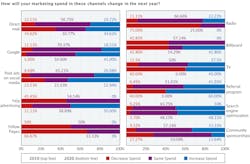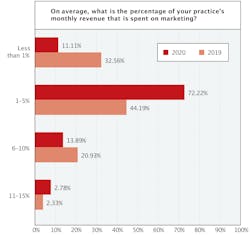Toward the tail end of every year, my team sends a marketing survey to all the dentists in our database. At the time of this writing, there are 6,481 dentists on this list. While not all of them have an active campaign and not all of them participate (it’s a limited sample), I still love conducting this survey. From these survey results, I gain amazing insight into the dental industry, and more specifically, into dental marketing strategies and their efficacy. And not to disappoint, this year’s survey was a doozy! The biggest eye-openers came when comparing last year’s survey results with this year’s. Here’s what really stood out to me.
Marketing sophistication
This year’s survey showed that dentists and their teams have become savvier when it comes to promoting their practices. How so? For one thing, they’ve made more adjustments to their overall marketing strategies.
When the results from this survey come in, I always turn to this question first: “How will your marketing spend in these channels change in the next year?” What struck me most about this year’s results was this: Very few practices were satisfied maintaining the same budgets used last year. This is a change from 2019, when the large majority planned to roll over their marketing budgets and allocations without alteration.
• 20% planned to decrease
• 57% planned to maintain
• 24% planned to increase
Compare that with the responses from this year:
• 36% plan to decrease
• 29% plan to maintain
• 35% plan to increase
What I find most heartening about the change is that it signals a trend away from doing the “same old, same old” year in and year out. Marketing is always changing because consumers are always changing. You can’t stand still and expect to get the same returns—you’ll become obsolete! This is why tracking your marketing is so vital. How can you know where to concentrate your budget if you don’t know what’s working?
Hopefully these results indicate that more of you are tracking your marketing and routinely analyzing the data to maximize your budget. That is the key to long-term marketing success. (If you aren’t tracking your marketing, you might want to adjust accordingly to keep up.)
Greater spending
In 2020, the number of respondents spending less than $1,000 per month dropped from 45% to 28%. The largest group (44%) is now spending between $1,000 and $5,000 per month on marketing. The number of respondents spending $5,001 to $10,000 per month jumped from 7% to 22%.
As a percentage of monthly revenue, 33% of practices last year reported spending less than 1% on marketing. This year, the number spending less than 1% of monthly revenue on marketing has dropped significantly—all the way down to 11% (figure 3).Review-focused
More dentists are making strides in Google reviews. For years, I’ve encouraged dentists to hone their review-generation strategy on Google, the top review site by a mile according to Alexa data.1 In other words, forget Yelp and those dental-specific directories. Forget all of that—set your sights on Google reviews. (And, OK, to a much lesser extent, Facebook.)
Looking at the results from this year’s survey, I think I may finally be getting through! Cumulatively, only 55% of practices claimed to have more than 25 Google reviews in 2019. This year, a whopping 75% of responding practices can claim more than 25 Google reviews (figure 4).
Also of note: Only 17% of respondents said they had 100-plus reviews in 2019. In 2020, that number jumped to 37%. Similarly, the number of practices with only 11 to 25 reviews fell from 31% to 11%.
Final thoughts
All things considered, I have to say that I was so pleased with this year’s survey results, which really show progress. It appears that, nationwide, dentists and their teams are making strides to be better informed and more in touch with their marketing strategies—a development that will pay dividends in spades.
Author’s note: To download the entire survey and see the dozen or so results I haven’t featured here, go to postcardmania.com/survey.
Reference
1. Abramyk H. Top 10 review websites to get more customer reviews on (2020). Vendasta website. https://www.vendasta.com/blog/top-10-customer-review-websites. Accessed January 29, 2020.
Joy Gendusa is the founder and CEO of PostcardMania. Using just postcards, a phone, and a computer, Gendusa built PostcardMania from a one-person start-up into an industry leader. PostcardMania serves 90,642 clients, including 6,481 dentists. Need help promoting your practice? Call one of PostcardMania’s dental marketing consultants at (844) 269-1836, or email Gendusa at [email protected].
About the Author

Joy Gendusa
Founder and CEO, PostcardMania
Joy Gendusa is the founder and CEO of PostcardMania. Using just postcards, a phone, and a computer, Gendusa built PostcardMania from a one-person start-up into an industry leader. PostcardMania serves 102,962 clients, including 6,980 dentists. Need help promoting your practice? Call one of PostcardMania’s dental marketing consultants at (844) 269-1836, or email Gendusa at [email protected].




